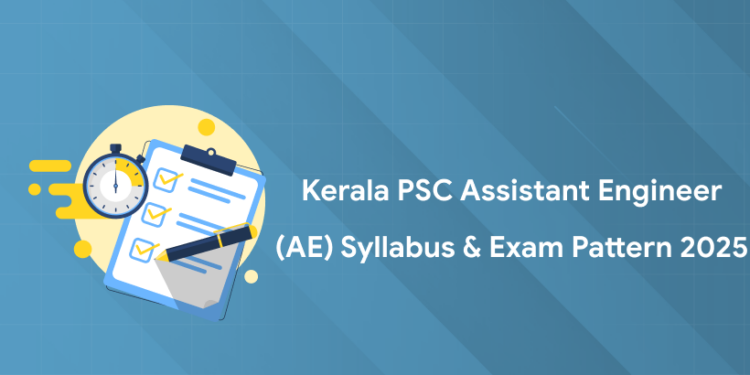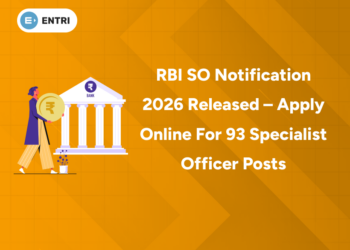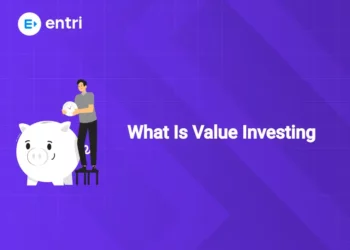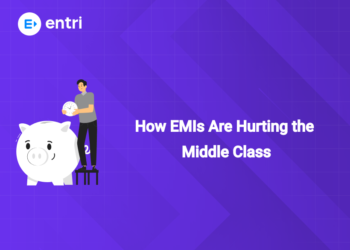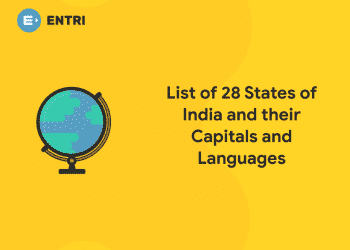Table of Contents
The Kerala Public Service Commission (KPSC) has officially released the detailed syllabus and exam pattern for the recruitment of Assistant Engineer in the Ground Water Department under Category No. 466/2025. It covers key subjects including Mechanical, Agricultural, and Mining Engineering, along with their modules and marks distribution. Note that questions may also arise from other topics prescribed for the qualification, and not all topics listed are guaranteed to appear in the exam. Explore detailed syllabus here!
Ace KPSC Technical Exams! JOIN NOW!
Kerala PSC Assistant Engineer Syllabus 2025 & Exam Pattern
| Particulars | Details |
| Name of recruiting organization | Kerala Public Service Commission (PSC) |
| Name of department | Ground Water |
| Name of post | Assistant Engineer |
| Category Number | 466/2025 |
| Number of vacancies | As per Notification |
| Exam Date | December 15, 2025 |
| Admit Card | December 01, 2025 |
| Mode of recruitment | Direct Recruitment |
| Mode of Exam | OMR |
| Official website | keralapsc.gov.in |
Kerala PSC Assistant Engineer Syllabus 2025 PDF
1: Between the period of 1858-1947, how many Viceroys ruled over India?
For a complete view of the syllabus, you can download the PDF version here. It includes all modules, marks distribution, and key topics for Assistant Engineer – Ground Water Department (466/2025), allowing easy offline access and reference.
Prepare for Kerala PSC Technical Exams with Entri
സർക്കാർ ജോലി എന്ന സ്വപ്നം ഇനി സ്വപ്നം മാത്രമല്ല! Join Kerala's Top-rated PSC Coaching Programs
Join NowKerala PSC Assistant Engineer Exam Pattern
The Assistant Engineer – Ground Water Department (466/2025) exam is scheduled for Monday, 15th December 2025. The exam will be conducted in English medium and consists of 100 questions totaling 100 marks. Each wrong answer will attract a negative marking of 1/3, and the duration of the exam is 1 hour and 30 minutes.
| Sl. No. | Subject / Module | Marks |
|---|---|---|
| 1 | Mechanical Engineering | 40 |
| 1.1 | Industrial Management & Industrial Engineering | 08 |
| 1.2 | Metallurgy & Machine Tools | 08 |
| 1.3 | Fluid Mechanics, Pneumatic & Hydraulic Machines | 08 |
| 1.4 | Applied Mechanics, Strength of Materials & Machine Design | 08 |
| 1.5 | Thermal Engineering | 08 |
| 2 | Agricultural Engineering | 30 |
| 2.1 | Module I – Tillage & Sowing Equipment | 03 |
| 2.2 | Module II – Harvesting & Farm Power | 03 |
| 2.3 | Module III – Hitching & Field Capacity | 03 |
| 2.4 | Module IV – Testing & Non-Conventional Energy | 03 |
| 2.5 | Module V – Wind & Bio-Energy | 03 |
| 2.6 | Module VI – Soil & Irrigation Management | 03 |
| 2.7 | Module VII – Surveying & Fluid Mechanics | 03 |
| 2.8 | Module VIII – Drainage & Irrigation Systems | 03 |
| 2.9 | Module IX – Processing & Size Reduction | 03 |
| 2.10 | Module X – Food Processing & Storage | 03 |
| 3 | Mining Engineering | 30 |
| 3.1 | Module I – Mining Geology | 02 |
| 3.2 | Module II – Mine Development | 03 |
| 3.3 | Module III – Drilling & Blasting | 04 |
| 3.4 | Module IV – Surface Mining | 03 |
| 3.5 | Module V – Underground Mining & Mineral Processing | 03 |
| 3.6 | Module VI – Mine Surveying | 02 |
| 3.7 | Module VII – Mine Planning & Computer Applications | 03 |
| 3.8 | Module VIII – Mining Machinery & Geomechanics | 03 |
| 3.9 | Module IX – Mine Environment & Ventilation | 03 |
| 3.10 | Module X – Mine Management, Legislation & Safety | 04 |
Kerala PSC Assistant Engineer Detailed Syllabus 2025
The following section provides the detailed syllabus for the Kerala PSC Assistant Engineer – Ground Water Department (466/2025) exam. It covers all major subjects, including Mechanical, Agricultural, and Mining Engineering, with their respective modules, marks distribution, and key topics.
Mechanical Engineering Syllabus
I) Mechanical Engineering
1) Industrial Management and Industrial Engineering – 08 Marks
Principles of Management
- Meaning of management
- Taylor’s Scientific Management
- Functions of management
- Different types of ownership
- Organizational structure
- Principles of a good wage payment system, minimum wages, incentives
- Quality planning and its developments – Definitions, dimensions, and TQM concepts
Project Management Techniques
-
Commonly used terms in CPM and PERT
-
Critical path, slack, or float
-
Comparison between CPM and PERT
Quantitative Techniques in Management
- Linear Programming – Formulation of LPP
- Transportation problem – Least Cost Method, North-West Corner Rule, Vogel’s Approximation Method
Inventory Management
- Definition and classification
- EOQ and ABC analysis
- Sales and sales forecasting
Production and Productivity
- Meaning of production and productivity
- Types of production – Job production, Batch production, Mass production, Continuous production
- Scheduling, Dispatching
- Plant location and layout – Factors to consider
- Types of layouts
Method Study
- Work study, Method study
- Process chart symbols – Operation process chart, Flow process chart, Man-machine chart, SIMO chart
- Principles of motion economy
- Objectives of work measurement
- Procedure of stopwatch time study
Quality Control
- Concept of quality and quality control
- Control charts – Introduction and types: X-bar, R, P, 100P, and C charts
Fundamental Statistical Concepts
- Frequency, frequency distribution, frequency plot
- Normal distribution curve
- Explanation of mean, mode, median, and standard deviation
Project Analysis
- Need and scope of project analysis
- Explanation of constituent elements of project analysis
2) Metallurgy and Machine Tools – 08 Marks
Metals and Alloys
- Structure of materials – Crystal structures: BCC, FCC, HCP
- Ferrous and non-ferrous metals
- Cast iron: Manufacturing of pig iron (Blast Furnace), Manufacturing of cast iron (Cupola Furnace)
- Types of steel, Manufacturing of steel
- Steel alloys, Non-ferrous metals and alloys (Aluminium, Copper)
- Crucible furnace
Heat Treatment Processes
- Iron-carbon equilibrium diagram, TTT diagram
- Microconstituents of steel
- Heat treatment processes
Properties, Testing, and Inspection of Materials
- Mechanical properties: Strength, hardness, toughness, brittleness, creep, fatigue, stiffness, ductility, malleability, elasticity, plasticity
- Thermal properties: Specific heat, thermal conductivity, thermal resistance, thermal diffusivity
- Destructive and non-destructive testing
Measuring Instruments
- Classification: Precision and non-precision instruments
- Direct reading and indirect measuring instruments
- Gauges and comparators
Welding and Joining
- Arc welding: Principles, electrode selection, electrode coatings
- Gas welding, Submerged arc welding, TIG, MIG, Atomic hydrogen welding, Thermit welding
- Soldering, brazing
- Welding defects: Porosity, poor penetration, warping, undercut, distortion, cracks, poor appearance – causes and remedies
Metal Cutting and Machine Tools
- Orthogonal and oblique cutting, Tool life, Machinability
- Lathes: Types, accessories, work holding, tool holding, speed, feed, depth of cut, taper turning methods, lathe specification
- Drilling machines: Classification, work holding, drill bits, tool holding, operations
- Shaping machines: Parts and functions
- Milling machines: Uses, parts, types, operations, indexing
- Grinding: Abrasives, bonding materials, types of grinding wheels
- Flexible Manufacturing System (FMS): Flexible automation, flexible manufacturing cell, components
- Computer Numerical Control (CNC)
3) Fluid Mechanics, Pneumatic and Hydraulic Machines – 08 Marks
Properties of Fluids
- Density, specific weight, specific volume, specific gravity, viscosity, Newton’s law of viscosity
- Types of fluids, compressibility, surface tension, capillarity
Fluid Pressure and Measurement
- Fluid pressure at a point, Pascal’s law
- Absolute, gauge, atmospheric, and vacuum pressures
- Pressure measuring devices
Types of Fluid Flow
- Steady/unsteady, uniform/non-uniform, laminar/turbulent, compressible/incompressible, rotational/irrotational
- Continuity of flow, energy of liquid motion, Bernoulli’s equation, practical applications
Impact of Jets
-
Force exerted by jets, Impulse turbines – classification, Pelton wheel components
Reaction Turbines
- Components, difference between impulse and reaction turbines
- Classification, specific speed
Pumps
- Types, Centrifugal pumps: Efficiencies, discharge, power required, multistage, specific speed, cavitation, priming
- Reciprocating pumps: Types, comparison with centrifugal pumps, discharge, slip, air vessels
- Hydraulic ram
4) Applied Mechanics, Strength of Materials, and Design of Machine Elements – 08 Marks
Direct Stresses and Strains
- Types: Tensile, compressive, longitudinal, lateral strain
- Poisson’s ratio, stress-strain diagram
- Elastic limit, yield point, ultimate stress, working stress, factor of safety
- Principle of superposition, stresses in varying/composite sections
Shear Stress and Strain
- Modulus of rigidity, volumetric strain, bulk modulus
- Thermal stresses
Friction
- Types: Static, dynamic, sliding, rolling, pivot
- Limiting friction, angle of friction, coefficient of friction, cone of friction
Moment of Inertia
-
Radius of gyration
Joints
- Riveted joints: Lap joint, single/double riveted, failure
- Welded joints: Terms, strength
Torsion
-
Torsion equation, strength equation for solid and hollow shafts, power equation, polar moment of inertia
Springs
-
Types: Leaf spring, helical springs
Beams
- Types: Cantilever, simply supported, overhanging, fixed, continuous
- Loading types, shear force and bending moment diagrams, maximum bending moment, deflection
Columns
-
Buckling load, equivalent length, slenderness ratio, short/medium/long columns
Thread Terminology
- Forms: Whitworth, British Association, American standard, Acme, ISO metric
- Single/multi-start, right-hand/left-hand threads, conventional representation
Limits, Fits, and Tolerances
-
Definitions, surface roughness terminology and values
Machine Design
- Design stress, working stress, factor of safety
- Kinematic links, pairs, chains, four-bar chain, mechanisms and inversions
- Shaft design: Strength, rigidity, power transmitted, couplings
- Bearings: Functions, classification, radial/thrust, sliding/rolling contact
- Followers and cams: Motion types, displacement diagrams
- Governors and flywheels: Functions, types, coefficient of fluctuation of energy
- Gears and gear trains: Functions, advantages/disadvantages, spur gear nomenclature, simple and compound gear trains
5) Thermal Engineering – 08 Marks
Air Standard Cycles
- Assumptions, air standard efficiency
- Carnot, Otto, Diesel, dual combustion cycles – diagrams and derivations
Fuels
- Classification: Solid, liquid, gaseous
- Requirements of good fuel, calorific value, combustion of fuel
I.C. Engine Performance
-
Testing, total and specific fuel consumption, Morse test of multi-cylinder engines
Heat Transfer
- Conduction, convection, radiation
- Fourier’s law, thermal conductivity
- Conduction through plane and composite walls
- Black body concept, Stefan-Boltzmann law
- Free and forced convection
- Heat exchangers: Classification, regenerative, parallel flow, counter flow, cross flow, LMTD
Air Compressors
- Construction, working, uses
- Classification: Reciprocating (single & two-stage), rotary, centrifugal, axial flow
- Fans and blowers
I.C. Engine Subsystems
- Fuel, ignition, cooling, lubrication systems
- Quantity and quality governing, hit-and-miss governing
Refrigeration & Air Conditioning
- Definition, COP, unit of refrigeration, reversed Carnot cycle
- Vapour compression system: Principle, components, COP
- Compressors, condensers, evaporators, expansion devices (capillary tube, thermostatic expansion valve)
- Refrigerants: Primary/secondary, desirable properties
- Psychrometry: Principles, uses, sensible heating/cooling, humidifying/dehumidifying
- Air conditioning: Definition, classification, factors affecting comfort, effective temperature, summer/winter/year-round systems
Agricultural Engineering Syllabus
Module I – Primary and Secondary Tillage Operations – 03 Marks
- Primary and secondary tillage operations: Mould board plough, disc plough – functional components, accessories, and attachments
- Chisel plough, subsoiler
- Horizontal and vertical suction of mould board plough
- Forces acting on tillage implements
- Field efficiencies
- Draft measurement of tillage implements and calculation of power requirement
- Sowing, planting, and weeding equipment
- Seed drills and planters: Types of seed metering mechanisms and furrow openers
- Calibration and adjustments of seed drills and planters
- Sprayers and dusters: Types of nozzles
Module II – Harvesting and Farm Power – 03 Marks
- Harvesting methods and technologies: Reapers (VCR), mowers, and chaff cutters
- Threshers: Types of threshing drums, factors affecting performance
- Winnowers
- Grain and straw combines: Computation of combine losses
- Tractors and power tillers: Engines, power transmission systems (clutch, gearbox, differential, and final drives)
- Tractor power outlets: P.T.O. power and drawbar power
- Determination of maximum drawbar pull
- Tractor tyres, traction aids
- Centre of gravity and moment of inertia of tractors
Module III – Hitching, Traction, and Field Capacity – 03 Marks
- Hitching of implements: Mounted, semi-mounted, and trailed types
- Traction mechanics: Pull and draft, coefficient of traction, tractive efficiency, weight transfer
- Calculation of field capacity and field efficiency
- Economics of machinery usage: Fixed costs, variable costs, estimating cost of operation, break-even point
Module IV – Testing, Ergonomics, and Non-Conventional Energy – 03 Marks
- Testing of tractors and farm machines: Types of tests, test codes, and procedures
- Ergonomic considerations in farm machine design: Anthropometry, energy expenditure assessment
- Vibration and noise levels, physiological effects
- Non-conventional energy sources: Solar thermal energy conversion, flat plate and concentrating collectors
- Solar constant, photovoltaic electric production, PV systems
Module V – Wind and Bio-Energy – 03 Marks
- Wind energy conversion: Power coefficient, Betz limit
- Bio-energy: Thermochemical conversion of biomass, biomass gasification, gasifiers
- Biochemical conversion: Anaerobic digestion, fixed and floating type biogas plants, biomass characteristics
- Gasifier technology: Types of gasifiers
Module VI – Soil and Irrigation Management – 03 Marks
- Soil properties influencing irrigation management
- Soil-water relations, infiltration characteristics, relevant equations
- Water requirement of crops
- Mechanics and types of soil erosion
- Soil loss estimation
- Biological and engineering measures to control erosion
- Water harvesting structures
- Estimation of mean rainfall, measurement of runoff (Cook’s method)
- Linear, aerial, and relief aspects of watersheds, stream order
- Watershed management: Factors and measures
- Hydrograph: Applications and limitations
Module VII – Surveying, Remote Sensing, and Fluid Mechanics – 03 Marks
- Surveying: Basic principles, classification, levelling (rise and fall system, classification)
- Total station and GPS survey
- Remote Sensing: Basic components, advantages, limitations, sensors, and platforms
- GIS: Basic components, spatial data, map projections, data models, integration
- Properties of fluids: Hydrostatic pressure and measurement
- Bernoulli’s theorem, laminar flow in pipes, general head loss equation, Darcy’s equation
- Major and minor losses in pipes and fittings
- Open channel hydraulics: Chezy’s and Bazin’s formula
- On-farm water conveyance structures: Control and distribution, drop structures
Module VIII – Drainage and Irrigation Systems – 03 Marks
- Surface and subsurface drainage: Coefficient, design parameters, hydraulic conductivity, drainable porosity, Hooghoudt’s spacing equation
- Hydraulics of flow in wells
- Centrifugal pumps: Total pumping head, NPSH, maximum suction lift, power requirement, performance curves
- Sprinkler and drip irrigation systems: Layout, hydraulic design of lateral, sub-main, and main pipelines
- Pump selection
Module IX – Processing and Size Reduction – 03 Marks
- Rheological properties: Force-deformation, stress-strain, elastic, plastic, and viscous behavior
- Drying: Theory of grain drying, moisture content, water activity, free, bound, and equilibrium moisture content
- Equipment for cleaning and grading
- Size reduction: Fineness modulus, principles of comminution, laws and procedures, crushing, impact, cutting, shearing
Module X – Food Processing, Preservation, and Storage – 03 Marks
- Principles of processing and preservation: Blanching and canning
- Thermal processing: Freezing, refrigeration, and cold storage
- Drying: Hysteresis effect, EMC determination, psychometric chart
- Grain dryers: Batch and continuous types; deep bed, flat bed, continuous flow, LSU dryers
- Storage of grains: Improved storage structures – CAP, hermetic storage, Pusabin, RCC ring bins
Mining Engineering Syllabus
Module I – Mining Geology – 02 Marks
- Geomorphology, Mineralogy, Petrology, Structural Geology, Economic Geology
- Prospecting techniques: Reconnaissance, principles and methods of prospecting by pit, shaft, trench, and boreholes
- Methods of ore body investigation
- Rock sampling techniques
- Ore reserve estimation methods and UN Framework Classification (UNFC)
Module II – Mine Development – 03 Marks
- History of mining: Contribution to human civilization and national economy
- Indian mineral resources and global status
- Role of mining engineers in industry
- Modes of entry: Applicability and limitations; comparison of opencast vs underground mining
- Selection of site and size
- Shaft sinking: Methods, support systems, ventilation, lighting, drainage, material handling, and safety
Module III – Drilling and Blasting – 04 Marks
- Drilling methods: Rotary, percussive, rotary-percussive, down-the-hole vs top hammer drilling
- Explosives and blasting agents: ANFO, slurry, emulsion, permitted explosives, bulk explosives
- Selection of explosives and blasting accessories
- Initiation systems
- Drilling and blasting patterns for underground excavations
- Advantages and limitations of blasting
- Storage and transport of explosives
- Safety measures and controlled blasting techniques
- Alternatives to explosives
Module IV – Surface Mining – 03 Marks
- Bench parameters, haul roads, selection of equipment
- Types of opencast equipment: Excavators, transport systems (road, conveyors)
- Pit slope stability: Modes of failure and stabilization
- Overburden removal and disposal
- Design of waste dumps
- Mine closure planning
- Introduction to hydraulicking, dredging, leaching, etc.
Module V – Underground Mining Methods and Mineral Processing – 03 Marks
- Factors affecting the choice of mining methods for coal and metalliferous mines
- Bord and pillar method: Development and extraction
- Longwall mining
- Special methods of working in coal deposits
- Stoping methods in metalliferous deposits
- Innovative techniques and special applications in metal mines
- Introduction to comminution, laboratory & industrial sizing, sampling, and control
- Separation/concentration methods
- Special methods of ore extraction
Module VI – Mine Surveying – 02 Marks
- Linear measurements, compass surveying, true meridian, magnetic meridian
- Open and closed traverse, traversing with compass and chain, permissible errors
- Levelling: Contouring, rise and fall system
- Theodolite: Temporary and permanent adjustments, permissible error for surface and underground
- Correlation surveys: Tachometry, dip, strike, fault problems
- EDM, GPS/DGPS, total station, introduction to remote sensing
- Stope and subsidence surveys
- Borehole surveying and calculations
- Types of mine plans: Preparation, care, storage, and preservation
- Legislation concerning mine plans and sections
- Duties and responsibilities of surveyors
- Application of computers in mine surveying and plan preparation
Module VII – Mine Planning, Design, and Computer Applications – 03 Marks
- Estimation of ore reserves based on borehole data
- Design of mine openings, opencast mines, bench geometry, pillars
- Design of underground support systems
- Production and productivity in mines
- Basic concepts of mine planning software: SURPAC, DATAMINE, VULCAN, and auxiliary software related to surveying, planning, and design
Module VIII – Mining Machinery and Geomechanics – 03 Marks
- Wire ropes: Classification, applicability, causes of deterioration, precautions, selection parameters
- Transportation in mines: Rope haulages, conveyors, locomotives, aerial ropeways
- Physical and mechanical properties of rocks
- Non-destructive testing methods
- Time-dependent properties of rocks
- Theories of rock failure, pillar design, rock burst
- Design of underground workings
- Stowing/filling methods
Module IX – Mine Environment and Ventilation – 03 Marks
- Air and water pollution: Causes, types, effects
- Sources of water pollution
- Analysis of air pollutants
- Air pollution control measures and equipment
- Methods and approaches to air pollution control
- Soil pollution and solid waste disposal
- Noise pollution and control
- Relevant acts and rules: Air and water pollution control, functions of state/central boards
- Mine gases, mine climate, and control
- Laws of air movement in underground mines
- Natural and mechanical ventilation, air current distribution, ventilation planning
Module X – Mine Management, Legislation, and General Safety – 04 Marks
- Mine organizational structure
- Legislation: Mines Act 1952, Mines Rules 1955, Metalliferous Mines Regulations 1961
- Directorate General of Mines Safety (DGMS) technical circulars
- Vocational Training Rules 1961
- Granite Conservation and Development Rules 1999
- Tamil Nadu Minor Mineral Concessional Rules 1959
- Environmental Protection Act 1986, Environmental Impact Assessment (EIA) notifications 1994 and 2006
- Environmental clearance procedures for mining projects
- Mine explosions and fires, inundation
- Safety audits in mines
- Accident analysis and investigation report compilation


